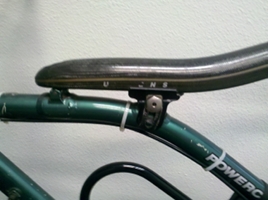 If you’ve never seen a Softride, or bikes that look like it, you might be wondering what’s going on here. No, this isn’t a folding bike. Rather, it belongs to a class of bikes known as beam bikes.
If you’ve never seen a Softride, or bikes that look like it, you might be wondering what’s going on here. No, this isn’t a folding bike. Rather, it belongs to a class of bikes known as beam bikes.
Beam bikes place the seat on a beam that attaches to the frame near the head tube and suspends the rider over the rear wheel without a seat tube or other support.
There actually are a few different manufactures of this frame design, many of them competitive. They had a growing following in the 1990’s among the time trial and triathlon crowd, up until the UCI got involved. In 1999, the UCI banned beam bikes – or more specifically, any bike without a seat tube – from competitive events, declaring them an unfair advantage.
 The particular beam bike pictured in this article is a Softride Solo 700, and it is currently doing duty as a commuter bike. It belongs to Mario, who picked it up from the Sacramento Bicycle Kitchen.
The particular beam bike pictured in this article is a Softride Solo 700, and it is currently doing duty as a commuter bike. It belongs to Mario, who picked it up from the Sacramento Bicycle Kitchen.
The concept of a beam bike works well for a commuter. On the solo 700, for example, the beam is made of carbon fiber. It is, essentially, a long shock absorber that helps isolate the saddle from the road vibrations and bumps.
Softride is no longer manufacturing bikes and closed the doors on their Bellingham, WA beam bike operations in 2006. However, they seem to still have a very active following among owners and riders.
Softride invented and popularized carbon beam bikes. For a brief time, Softride was the fastest growing bike company. Their bikes consistently set records and won Ironman triathlons. After the UCI banned beam bikes from competition, Softride quit bike production in 2006
One of the first questions you may have is how to adjust the saddle height. If you look closely at the mount point of the carbon fiber beam (pictured above) you see that it is in fact a pivot point. This allows you to rotate the beam and raise or lower the saddle compared to the pedals. In addition, the saddle itself offers adjustments of both rotation (nose up/nose down) and fore-aft placement. Ultimately you actually get a large amount of adjustment potential. Some, however, state that these adjustments can be more difficult to get dialed in right compared to a more traditional seat tube design.
Be sure and give Mario a wave if you see him cruising around Sacramento. Cheers for being a bicycle commuter, and cheers for helping to keep a part of cycling history alive.